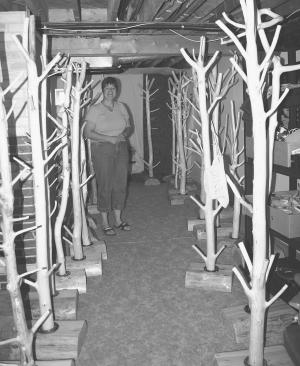2006 - Volume #30, Issue #1, Page #06
[ Sample Stories From This Issue | List of All Stories In This Issue | Print this story
| Read this issue]
Coat Racks Made From Aspen Trees
 |
Lois Robinson and her husband, Darrell, farm near Fort Assiniboine. Seven years ago Lois got the idea of making a coat rack to hold dirty coveralls out on her deck. After locating a suitable tree, she carefully cut off all the branches. She then drilled holes in strategic parts of the tree and stuck branches into the holes. It didn't take long to realize that using a tree with branches already in the right places would work a whole lot better.
The trees that Lois uses grow on their farm. Whenever she is out helping Darrell with farm chores, she'll be watching for suitably-shaped trees. She says, "I can go past a tree dozens of times and, all of a sudden, I realize it's the right tree!" Often she'll take the quad to go on a tree search and finds that fence lines are good places to look. A tree that has been bent or damaged when young often results in an interesting shape. She says that she is becoming "more artsy" in her creations as people want tree stands that are unusual and eye-catching as well as useful.
During the winter, Lois will mark trees to be cut in the spring. In order to peel well, the trees are cut in the sap stage from the middle of May to the middle of July. After being peeled, they are put in an unheated shop to dry for a year.
When a tree is dry, it is sanded and then finished with three coats of exterior varnish so it can be used indoors or outside. Each tree has a solid tamarack base. Lois has local mills saw tamarack logs into suitably sized blocks. When the blocks are sanded and finished, Lois drills a hole to fit the base of the tree and screws the tree in place to ensure that it will remain sturdy.
Six to eight hours of work go into a tree depending on its size. Lois has converted an old house into a shop where she has her tools set up and also, since the shop is not heated, where trees are stored while they dry. She prefers to do the sanding outside.
The first trees that Lois made are being used in her own home as coat trees, a towel tree in the bathroom and decorative trees. When family members admired the trees, both for their attractiveness and their usefulness, Lois began to make trees as gifts. She also created trees on consignment for people who wanted to purchase one.
Although marketing is not as much fun as creating, Lois is now concentrating on building up her inventory and plans to get into some of the bigger craft and farmers markets. In July 2005, Lois had a vendor's table for three days at a special Fort Assiniboine Farmers Market which was held during the World Masters Orienteering event at Fort Assiniboine. She felt that this would give her work more exposure and she was pleased when she sold two trees, one of which went to Whitehorse, Yukon.
Lois also has trees consigned at The Rusty Cup, a restaurant and craft shop in the area, and at the North Bow Lodge SE of Calgary near Dalemead. These businesses, as well as a jewelry store in Barrhead, Alta. have purchased display trees from Lois.
Lois enjoys her craft and takes pride in her work. Being able to work at home and to use a local resource is a bonus! You can visit her website at www.losibugs.ca to view her trees.

Click here to download page story appeared in.

Click here to read entire issue
To read the rest of this story, download this issue below or click here to register with your account number.




